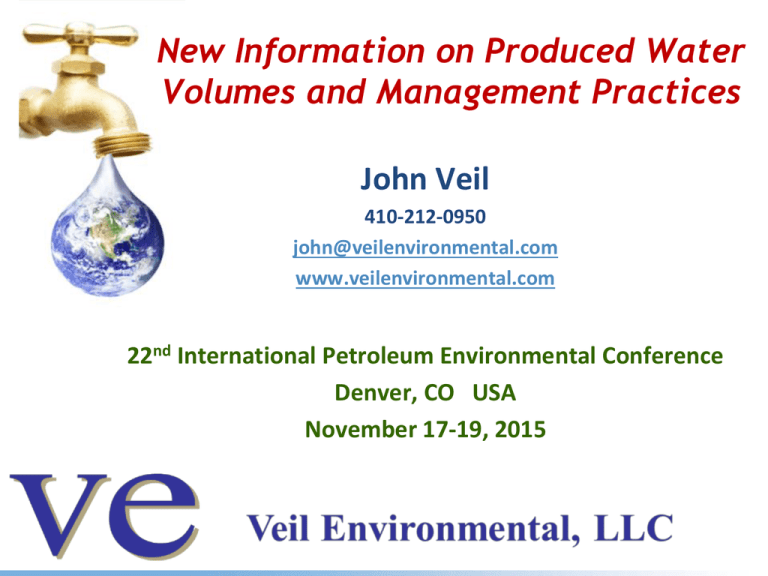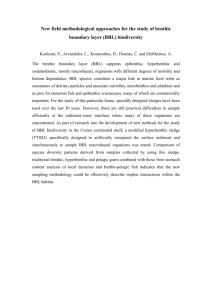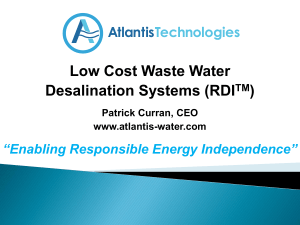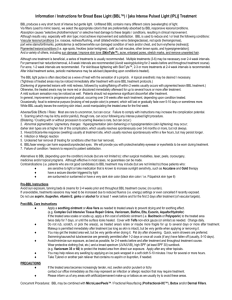New Information on Produced Water Volumes and Management Practices John Veil 22
advertisement

New Information on Produced Water Volumes and Management Practices John Veil 410-212-0950 john@veilenvironmental.com www.veilenvironmental.com 22nd International Petroleum Environmental Conference Denver, CO USA November 17-19, 2015 Key Produced Water Points There are nearly 1 million oil and gas wells in the U.S. that generate a very large volume of produced water Different types of oil and gas production have different water needs and generate different amounts and types of wastewater Oil and gas companies must manage the water in a way that meets regulations and has an affordable cost There are different water management options that are chosen in different locations. The oil and gas companies may choose different options and strategies over time as the factors affecting their decisions change. 2 Produced Water Inventory for the U.S. in 2007 • Clark, C.E., and J.A. Veil, 2009, Produced Water Volumes and Management Practices in the United States. • The report contains detailed produced water volume data for 2007 • ~21 billion bbl/year or 58 million bbl/day • 882 billion gallons/year or 2.4 billion gallons/day http://www.veilenvironmental.com/publications/pw/ANL_EVS__R09_produced_wat er_volume_report_2437.pdf 3 U.S. Produced Water Volume by Management Practice for 2007 (1,000 bbl/year) Injection for Enhanced Recovery Injection for Disposal Surface Discharge Total Managed Total Generated Onshore Total 10,676,530 7,144,071 139,002 18,057,527 20,258,560 Offshore Total 48,673 1,298 537,381 587,353 587,353 10,725,203 7,145,369 676,383 18,644,880 20,995,174 Total • Onshore – 98% goes to injection wells • 60% to enhanced recovery • 40% to disposal • Offshore – 91% goes to discharge 4 Update to Detailed Produced Water Inventory for the U.S. • GWPC contracted with Veil Environmental to update the earlier report using 2012 as the baseline year. • Data were collected during the second half of 2014 • Report was published in April 2015 http://www.veilenvironmental.com/publications/pw/prod_water_volume_2012.pdf 5 Approach • Data were collected from state oil and gas agencies • Agencies were asked to complete two tables showing oil, gas, and water production volumes and water management practices • Additional data were collected from some state environmental protection agencies and from several federal agencies (EPA, BLM, BOEM/BSSE • All water coming to the surface from an oil or gas well, regardless of its origin, was counted as produced water • Produced (formation) water • Frac flowback water • Water resulting from enhanced recovery operation • Data and details were summarized for each state separately 6 Example of a State Summary - Nebraska 7 Nebraska Summary (2) 8 Observations from the 2015 Study • • • • Produced water volume Produced water management practices Data availability Data quality 9 Produced Water Volumes 10 Five Year Changes in Fluid Production • Between 2007 and 2012 • U.S. oil production increased by 29% • U.S. gas production increased by 22% • U.S. water production increased by <1% • 21.2 billion bbl vs. 21 billion bbl 11 Top Ten States in 2012 Water Production Ranking 1 2 3 4 5 6 7 8 9 10 State Texas California Oklahoma Wyoming Kansas Louisiana New Mexico Alaska Federal Offshore Colorado 2012 Water (bbl/yr) 7,435,659,000 3,074,585,000 2,325,153,000 2,178,065,000 1,061,019,000 927,635,000 769,153,000 624,762,000 358,389,000 320,191,000 % of Total Water 35 15 11 10 5 4 4 3 2 2 Ratio of Water to Oil Production Not all states provided separate water from oil production and water from gas production The weighted average water-to-oil (WOR) for 21 states is 9.2 bbl water/bbl oil. – Two of the key water producing states (Texas and Oklahoma) were unable to distinguish the water generated from oil wells vs. water coming from gas wells. Both of those states have large numbers of older wells from mature fields that typically have very high WORs (much higher than the weighted average). It is very likely that if the wells from those states were averaged in, the national weighted average WOR would be higher than 10 bbl/bbl. State Alabama Alaska Arizona Arkansas California Illinois Indiana Kansas Michigan Mississippi Missouri Montana Nebraska Nevada New Mexico New York North Dakota Ohio South Dakota Virginia Wyoming Total Volume Weighted Average WOR Crude Oil (bbl/year) Water from Oil (bbl/year) WOR 11,310,000 37,858,000 3.3 192,368,000 51,900 6,567,600 768,133,000 66,700 174,614,000 4.0 1.3 26.6 197,749,000 8,908,000 2,350,000 43,743,000 7,400,000 24,146,000 175,000 26,495,000 2,514,000 368,000 85,341,000 360,000 3,071,362,000 105,268,000 48,931,000 971,009,000 25,000,000 228,069,000 2,103,000 179,085,000 57,873,000 5,865,000 674,902,000 208,000 15.5 11.8 20.8 22.2 3.4 9.4 12.0 6.8 23.0 15.9 7.9 0.6 243,272,000 5,063,000 1,754,000 9,700 284,426,000 4,860,000 5,296,000 54,400 1.2 1.0 3.0 5.6 45,382,000 1,646,601,000 36.3 905,327,200 8,291,584,100 9.2 Ratio of Water to Gas Production The weighted average water-to-gas ratio (WGR) for 17 states is 97 bbl water/Mmcf gas. – The range of values from the different states was so large that using a WGR is not meaningful. Total Gas (Mmcf) State Alabama Alaska Arizona Arkansas California Indiana Kansas Michigan Mississippi Montana Nebraska New Mexico New York North Dakota Ohio Virginia Wyoming Total Volume Weighted Average WGR 216,000 3,182,000 116 1,137,000 174,000 8,800 299,000 130,000 437,000 67,000 1,200 1,252,000 27,000 259,000 86,000 146,000 2,079,000 9,501,116 Water from Gas (bbl/year) 68,761,000 1,019,000 14,200 10,253,000 3,222,000 8,635,000 90,010,000 92,000,000 3,167,000 3,748,000 769,000 101,028,000 301,000 6,721,000 682,000 3,177,000 531,464,372 924,971,572 WGR 318 0.3 122.4 9.0 18.5 981.3 301.0 707.7 7.2 55.9 640.8 80.7 11.1 25.9 7.9 21.8 255.6 97 Why Did Oil and Gas Increase While Water Remained the Same? Here is my hypothesis: Conventional production generates a small initial volume of water that gradually increases over time. The total lifetime water production from each well can be high Unconventional production from shales and coal seams generates a large amount of flowback and produced water initially but the volume drops off, leading to a low lifetime water production from each well Between 2007 and 2012, many new unconventional wells were placed into service and many old conventional wells (with high water cuts) were taken out of service The new wells generated more hydrocarbon for each unit of water than the older wells they replaced Three Example States Showing Changes from 2007 to 2012 That Support the Hypothesis Arkansas: – Oil production increased nearly 8% – Gas production (mostly from the unconventional Fayetteville Shale) increased by over 400% – Water production increased by 11% North Dakota: – Oil production (mostly from the unconventional Bakken Shale) increased by over 500% – Gas production increased by over 300% – Water production increased by just 216% Pennsylvania: – Oil production increased by 280% – Gas production (mainly from the unconventional Marcellus Shale) increased by more than 1,300% – Water production increased by 870%. Produced Water Management Practices 17 2012 Produced Water Management Practices Water management follows similar trends to the 2007 data – Nearly all water from onshore wells is injected – Nearly all water from offshore wells is treated and discharged 2012 Produced Water Management Practices Water management follows similar trends to the 2007 data – Nearly all water from onshore wells is injected – Nearly all water from offshore wells is treated and discharged Injection for Enhanced Recovery (bbl/yr) Injection for disposal (bbl/yr) Surface discharge (bbl/yr) Evaporation (bbl/yr) Offsite Commercial Disposal (bbl/yr) Beneficial Reuse (bbl/yr) Total Prod Water Managed (bbl/yr) 2012 Onshore Total % Offshore Total % U.S. Total % 9,225,152,000 7,947,716,000 605,129,000 691,142,000 1,373,131,000 125,737,000 19,968,007,000 46.2 39.8 3.0 3.5 6.9 0.6 100.0 62,703,000 62,703,000 515,916,000 0 0 0 641,322,000 9.8 9.8 80.4 0.0 0.0 0.0 100.0 9,287,855,000 8,010,364,000 1,121,045,000 691,142,000 1,373,131,000 125,737,000 20,609,274,000 5.4 3.4 6.7 0.6 100.0 45.1 38.9 2007 Onshore Total % Offshore Total % U.S. Total % 10,676,530,000 7,144,071,000 139,002,000 No data No data No data 17,959,603,000 59.4 39.8 0.8 No data No data No data 100.0 48,673,000 1,298,000 537,381,000 No data No data No data 587,353,000 8.3 0.2 91.5 No data No data No data 100.0 10,725,203,000 7,145,369,000 676,383,000 No data No data No data 18,546,955,000 57.8 38.5 3.6 No data No data No data 100.0 Water Management other than Injection and Discharge The 2012 data provide more information on other practices Evaporation is used in several western states Where offsite commercial disposal facilities are available, some of the water is sent there. – Most commercial facilities use disposal wells – Some use evaporation ponds Beneficial reuse (other than reinjection for enhanced recovery operations) is difficult to quantify – Some states recycle their flowback water to make new drilling and frac fluids – Some states allow spreading of produced water on unpaved roads for dust control and on other roads for deicing during winter weather – There is limited reuse for irrigation in a few states where the water already has low salinity or has been treated to low salinity Data Availability 21 2012 Data Availability • Some states collect produced water volume data – many do not • Some times more than one agency has responsibility for relevant data – often they don’t know what data the other agency has • Unless state law or regulation requires produced water data submittal, the companies will not do it • Companies only provide the data elements that are required • Other than injection volumes, most states do not keep track of how produced water is managed • Particularly true for beneficial reuse • Data can be stored in huge databases that require IT expertise for making queries • Regulatory staff may not know how to do queries • State agencies are often overworked and understaffed • They have little time to compile data for external requests 22 2012 Data Availability (2) • Where data were not available through the state agencies, additional efforts were made to estimate water volumes and management practices. • Online databases • Other reports • Extrapolations from nearby states • Many assumptions were necessary. The report tries to state the assumptions clearly. • Other readers may disagree with those assumptions, which could lead to other findings or conclusions • Some federal agencies were able to provide requested data directly, while other insisted on a cumbersome FOIA process that often took more than a month. • The FOIA requirement was applied inconsistently, even within the same agency. • One agency charged for its services. 23 Data Quality 24 2012 Data Quality • The raw data are not precise. Water volumes are measured by comparing relative heights in a tank, by pump capacity and running time, or by bucket and stopwatch, among other methods. These methods give results that have some relevance to true volume, but are not precise. • The process of getting data from the field to the agencies has potential for additional errors. • • • • Transcription of field notes to paper forms or electronic forms Transcription into agency databases Inconsistent interpretation of what and how to report by companies Rounding errors (i.e., significant figures) 25 Final Thoughts • The 2012 data are imprecise but represent the most complete and current estimates available • This type of national data collection effort is very difficult and time-consuming • There is no easy way to obtain national estimates of produced water volume • In the absence of a consistent methodology to collect produced water volumes and management information, it is unlikely that the challenges of estimating produced water volumes and management practices will decrease in the future 26




